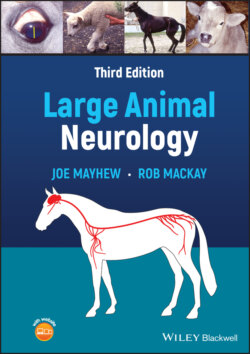Читать книгу Large Animal Neurology - Joe Mayhew - Страница 64
Computed tomography
ОглавлениеComputed tomography (CT) and CT contrast myelography have some advantages over unenhanced radiography but at an expense. More detailed imaging of bony structures such as vertebrae and petrosal, basilar and hyoid bones, being able to view structures in three planes and perform anatomical reconstructions can be definite advantages for diagnostic purposes.102,135–141 CT also images some soft tissue lesions well.113,142–163 The utility of CT for imaging of large animals has been enhanced at a few high‐end referral centers by the development of large‐bore mobile scanners and robotic‐controlled, gantry‐less digital systems. Both of these methods enable high‐resolution CT imaging of the heads and cervical vertebrae of standing, awake horses. Examples of the detail in image definition and some aspects of the diagnostic utility of CT myelography are shown in Figures 3.15 and 3.16.
Figure 3.15 A, B & C are transverse, dorsal, and median plane views, respectively, of CT myelogram centered on the C3‐4 intervertebral site of a 16‐month‐old ataxic Thoroughbred colt with Type‐I CVM. The dashed blue line in A traces the outer circumference of the C3‐4 intervertebral disc. Transverse (A) and dorsal (B) projections were reconstructed in the planes shown as a and b in C. Although dorsal flaring of the caudal vertebral body of C3 (arrow) and a kyphotic angle between C3 and C4 are obvious in C, spinal cord compression is not clearly revealed in A. Conventional radiographic myelography was required to demonstrate dynamic dorsoventral spinal cord compression at this site. Early osteochondral degenerative changes are evident in the articular process joints. There are osteophytes at the dorsal joint margins, sclerosis of the articular aspects of the C3 processes and cavitation of articular surfaces of C4 with possible bony fragmentation (orange circles).
